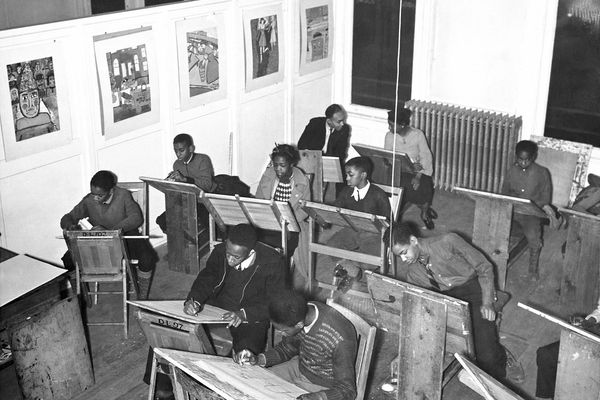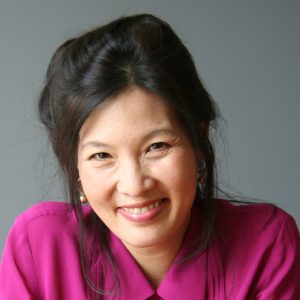by Nina Silber

A Class at the Harlem Community Art Center Funded by the Federal Arts Project
Tensions have been brewing at George Washington High School in San Francisco over a series of murals that tell a less than heroic story about America’s first president. Completed in 1936 by a left-wing immigrant painter, Victor Arnautoff, the murals have prompted discomfort among students and parents. Their objections focus not on the mural’s critique of Washington but on its inclusion of a dead Native American and African American slaves. Although Arnautoff apparently intended to expose Washington’s racist practices – his ownership of slaves, his role in killing Native people – the mural also shows people of color in positions associated with servitude and violence. Given that, it’s not hard to imagine the uneasiness students of color might feel as they walk, everyday, past these paintings. A committee recently recommended painting over the offending frescoes.
Members of the George Washington High School community should have the ultimate say in the types of images chosen to represent their school. But there’s also a backstory to these murals – and other art works like it – that could easily be obscured in this discussion. A recent New York Times article puts the San Francisco dispute in the context of the many controversies currently swirling over “historical representations in public art”, including protests about “Confederate statues and monuments” that have recently “been dismantled”. While it’s true that Confederate monuments were placed in public spaces – like city parks and courthouse squares – and so might be considered a type of “public art”, the George Washington High School murals are a different order of “public art” altogether. Both were placed in public spaces but only one took shape as a result of public funding.
The San Francisco murals sprang from a broad government-funded arts initiative, part of Franklin Roosevelt’s New Deal, which made possible the creation of thousands of art projects around the United States in the 1930s. Part of the Works Progress Administration, these arts initiatives included numerous dramatic performances organized by the Federal Theatre Project; countless posters and murals created by the Federal Art Project; and the mammoth American Guide series as well as oral histories of black and white Americans done under the auspices of the Federal Writers Project. Significantly, these projects offered employment to artists, writers, dramatists, and musicians hit hard by the economic circumstances of the Great Depression.
In contrast, the money behind Confederate monuments and statues came almost exclusively from…
Read more at:

 Sheryl WuDunn, the first Asian-American reporter to win a Pulitzer Prize, is a business executive, lecturer, and best-selling author. Currently, she is co-founder of FullSky Partners, which works with socially-driven ventures, and a Venture Partner at Piedmont Partners Group Ventures, a small private equity group based in San Francisco.
Sheryl WuDunn, the first Asian-American reporter to win a Pulitzer Prize, is a business executive, lecturer, and best-selling author. Currently, she is co-founder of FullSky Partners, which works with socially-driven ventures, and a Venture Partner at Piedmont Partners Group Ventures, a small private equity group based in San Francisco. Nicholas D. Kristof, a columnist for The Times since 2001, is a two-time Pulitzer Prize winner who writes op-ed columns that appear twice a week. Mr. Kristof grew up on a sheep and cherry farm near Yamhill, Oregon. He graduated Phi Beta Kappa from Harvard College and then studied law at Oxford University on a Rhodes Scholarship.
Nicholas D. Kristof, a columnist for The Times since 2001, is a two-time Pulitzer Prize winner who writes op-ed columns that appear twice a week. Mr. Kristof grew up on a sheep and cherry farm near Yamhill, Oregon. He graduated Phi Beta Kappa from Harvard College and then studied law at Oxford University on a Rhodes Scholarship.